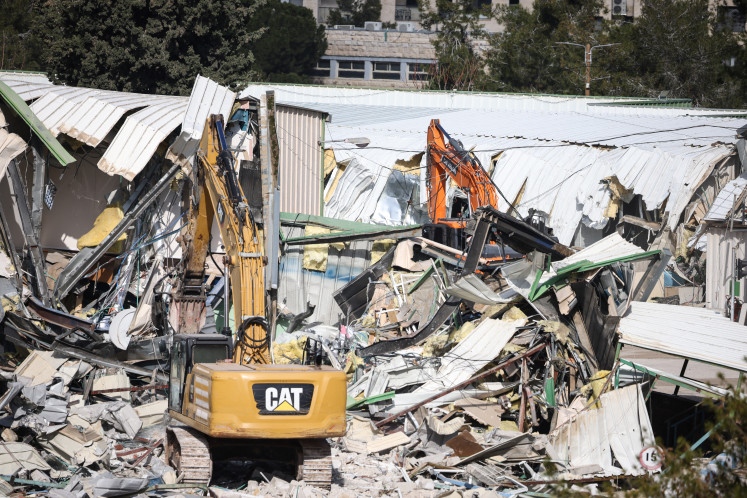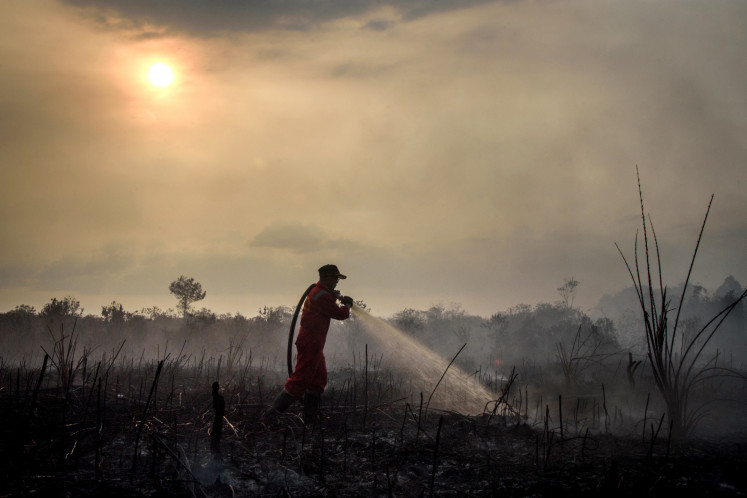Popular Reads
Top Results
Can't find what you're looking for?
View all search resultsPopular Reads
Top Results
Can't find what you're looking for?
View all search resultsKecak's origin: The dance that saved a village
Rebirth: Kecak has evolved from its roots in Bona village
Change text size
Gift Premium Articles
to Anyone
R
span class="caption" style="width: 496px;">Rebirth: Kecak has evolved from its roots in Bona village. The traditional male dance now can be performed by women and features the Ramayana epic.
Banging buckets, whacking kettles and clashing cymbals.
Making enough racket to wake the dead was the only method available to Bona villagers if they wanted to ward off deadly disease in the early 20th century.
Blighted annually by a deadly pox that washed over the village, with monsoons bringing storms in the month of November known as Sasih Kelima, Bona's villagers knew every family would lose at least one member to the disease, thought to be small pox. Their only defense was the hopeless banging of buckets in the wind.
World-renowned dancer and sculptor Made Sija remembers the fear and woe that seeped through his tiny village as disease cut a swath through the villagers' ranks.
Around 5 years old in 1935, today the 83-year-old's thunder-like roar of 'cak cak cak cak cak', his hands aloft and shaking, helps him remember the birth of Kecak, a fiery dance performed across Bali, but ' intriguingly ' no longer in Bona.
Today, the dance contains shades of the Ramayana epic, of Rama and Sita, the lovers at the center of a war pitting good against evil. Stage directions have been introduced by artist Walter Spies to the later Bedulu Kecak performances.
But Kecak's true roots are far richer and more tragic than any fable can tell.
'Kecak started here in Bona in the 1930s. People were ill, they were vomiting, they had diarrhea,' says Sija. 'Things worsened until the sick were vomiting blood and had fevers. A lot of people died. In one day there could be as many as four funerals, the next five, and on it went, day after day, week after week. Every year we faced this.'
Undying flame: The dynamic fire dance is still popular with tourists and local residents alike in Bali.
Sija lost an elder sister to the disease, which he says turned the skin black and spared the lives of very few.
With no doctors and with all temples and holy places locked and barred from giving help, making noise was perceived to be the only method left to ward off the disease.
'People knocked on their beds before sleeping to hold off their fear of the disease. We hoped that by knocking, the noise would keep away the disease. Sasih Kelima was the month of illness,' says Sija.
'Every villager believed this so we would go out of our houses and bang on everything, bamboo, buckets, nails, wood, anything that made a noise to cast away our fears of the illness.'
Sija said no religious ceremonies or offerings could halt the disease.
'The temples were all closed. People could not enter because every family had lost someone, and so the families were unclean. We couldn't hold ceremonies for the dead, which were so many,' says Sija dressed in sarong, his hair long and black, marking him out as an artist.
At 83, his memory and ability to dance are as strong as ever.
Despite the dark, silent temples abandoned by priests, Sija says the community still went there to create a cacophony of resistance against the perceived demons of the disease.
'One night there was a man who became possessed by the rhythm ' not the rhythm of the gong, but of human voices,' says Sija, breaking into the Kecak song, his voice deep but rising like a storm.
'From that moment, the disease started to ease and the death and the illness stopped.'
This was the beginning of Kecak.
To this day, the people of Bona believe the beginning of the dance outside the temple walls on that black night of death and disease, saved the village.
'Since then, every odalan [six months], we perform the Kecak with 150 dancers. We believe if we dance the Kecak it can cure people. We had no other dance, no Legong, no Rajang. For the people of Bona it was just the Kecak,' says Sija.
By the 1970s, Bona's Kecak was attracting attention. Dancers were invited to perform it in Kuta, Ubud and Legian.
'In Bona we no longer have Kecak. There is Kecak in Kuta, Legian and Ubud. In the past, tour operators brought visitors here to see the dance, but they asked for beer and food and more and more commission. Our village refused, so the guides took people to see Kecak in other areas. They said Bona had no Kecak, explained the artist.
'How can tourists know that this village is the birthplace of Kecak?' asks Sija, adding that with the transportation of this highly charged fire dance to tourist areas, the dance was altered, fused with motifs and myths that were never part of the original dance.
'The dance gave us back our spirit. Kecak is a movement of the shoulders. It makes you stronger and to the people of Bona this was the dance that purged an epidemic. This gives us a great sense of pride, because this dance was born and grew here. Even if it is still performed in other places, we know it came from here,' says Sija.
Bona's Kecak troupes of 150 dancers perform today by special request.
They still perform the original version, called into being through trances in a time of pestilence, outside temple walls that were barred to both the dead and the living.
' Photos by J.B. Djwan












